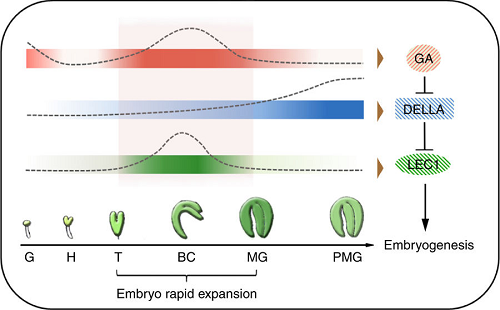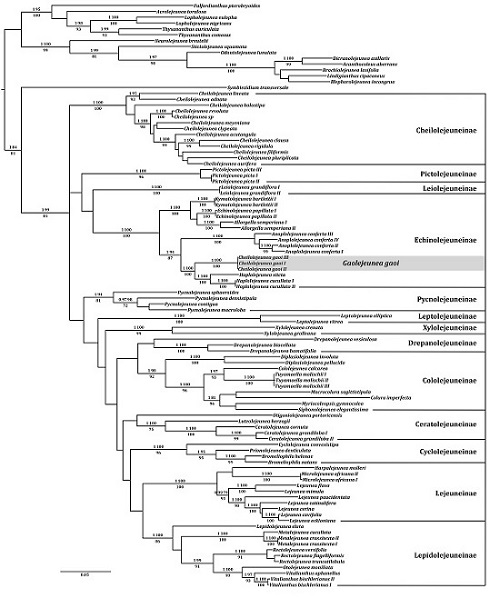News
-
2018-05-31SCBG Reported That Gibberellins Play an Essential Role in Late Embryogenesis of ArabidopsisThe plant hormone gibberellin ( GA ) plays key roles in almost all aspects of plant development , but its detailed function and underlying regulatory mechanism in embryo development are not yet clearly defined .A research team led by Prof . Hou Xingliang from South China Botanical Garden ( SCBG ) of the Chinese Academy of Sciences discovered an ...Read More
The plant hormone gibberellin (GA) plays key roles in almost all aspects of plant development, but its detailed function and underlying regulatory mechanism in embryo development are not yet clearly defined.
Recently, a research team led by Prof. Hou Xingliang from South China Botanical Garden (SCBG) of the Chinese Academy of Sciences d... -
2018-05-08What explains high plant richness in East Asia? Time and diversification in the tribe Lysimachieae (Primulaceae)What causes the disparity in biodiversity among regions is a fundamental question in biogeography , ecology , and evolutionary biology .We find that neither time nor diversification rates alone explain richness patterns among regions in Lysimachieae . Instead , a new index that combines both factors explains global richness patterns in the group...Read More
What causes the disparity in biodiversity among regions is a fundamental question in biogeography, ecology, and evolutionary biology. Evolutionary and biogeographic processes (speciation, extinction, dispersal) directly determine species richness patterns, and can be studied using integrative phylogenetic approaches. However, the strikingly... -
2018-05-04A Series of Researches on The Response of Tree Radial Growth to Global ChangesTree growth of boreal forest plays an important role on global carbon ( C ) cycle , while tree growth in the western Canadian boreal mixed forests has been predicted to be negatively affected by regional drought .Results indicated that tree growth of two species were both primarily affected by competition or tree size , while climatic indices sh... Tree growth of boreal forest plays an important role on global carbon (C) cycle, while tree growth in the western Canadian boreal mixed forests has been predicted to be negatively affected by regional drought. Individual tree growth can be controlled by many factors, such as competition, climate, tree size and age. However, information about con...Read More
-
2018-04-28A new endemic genus of China bryophytes, GaolejeuneaDiscovered in 1974 by Prof . Chien GAO , an acknowledged authority on Chinese bryology , at Hongqilinchang ( now Shiwandashan National Forest Park ) , Shangsi , Guangxi , Cheilolejeunea gaoi R . L . Zhu .However , the presence of Allorgella-type denticulations that formed by two adjacent cells on leaf and underleaf margins , small ovate leaf lob... Discovered in 1974 by Prof. Chien GAO, an acknowledged authority on Chinese bryology, at Hongqilinchang (now Shiwandashan National Forest Park), Shangsi, Guangxi, Cheilolejeunea gaoi R.L.Zhu, M.L.So et Grolle was a peculiar member of the Chinese Lejeuneaceae. It was described as a new species of Cheilolejeunea (Cheilolejeuneinae, Lejeuneeae) in ...Read More
-
2018-04-26The “International Long Term Ecological Research Network (ILTER) Next Generation Workshop” was held successfully in Zhaoqing, GuangdongSponsored by Chinese Ecosystem Research Network ( CERN ) , organized by South China Botanical Garden , Chinese Academy of Sciences ( SCBG-CAS ) , and co-organzied by the secretariat of the scientific committee of CERN .Three long term ecological research stations in SCBG , including Dinghushan station , Heshan station and Xiaoliang station were ... Sponsored by Chinese Ecosystem Research Network (CERN), organized by South China Botanical Garden, Chinese Academy of Sciences (SCBG-CAS), and co-organzied by the secretariat of the scientific committee of CERN, the “International Long Term Ecological Research Network (ILTER) Next Generation Workshop” was held from 16 to 21st April 2018 in Zha...Read More
-
2018-04-25Phylogeography and conservation genetics shed light on the conserveation strategy of the rare and relict Bretschneidera sinensis (Akaniaceae)Bretschneidera sinensis Hemsl . , a relic of the ancient Tertiary tropical flora endemic to Asia , is one of the Chinese class-I protected wild plants .Sporadically distributed in mountain forests of provinces south of the Yangtze River in China , it has recently also been found in Myanmar , Thailand , and northern Vietnam . As an ancestral spec...Read More
Bretschneidera sinensis Hemsl., a relic of the ancient Tertiary tropical flora endemic to Asia, is one of the Chinese class-I protected wild plants. Sporadically distributed in mountain forests of provinces south of the Yangtze River in China, it has recently also been found in Myanmar, Thailand, and northern Vietnam. As an ancestral specie... -
2018-02-11Genomic signature of adaptive divergence despite strong non-adaptive forces on edaphic islands: a case study of Primulina juliaeBoth genetic drift and divergent selection are expected to be strong evolutionary forces driving population differentiation on edaphic habitat islands .Populations with the lowest genetic variation were most genetically differentiated from other populations and the extent of genetic drift increased with geographic distance from other populations...Read More
Both genetic drift and divergent selection are expected to be strong evolutionary forces driving population differentiation on edaphic habitat islands. However, the relative contribution of genetic drift and divergent selection to population divergence has rarely been tested simultaneously. In this study, RAD-based population genomic analys... -
2018-02-05Evolutionary transitions from distyly to homostyly: the ecological correlates and genetic consequencesHeterostyly is an adaptation found in numerous families that enables outbreeding in dioecious flowers , complementing self-incompatibility mechanisms .Identifying the environmental conditions favouring transitions to selfing and determining their population genetic consequences can provide insights into how often and why selfing evolves in heter... Heterostyly is an adaptation found in numerous families that enables outbreeding in dioecious flowers, complementing self-incompatibility mechanisms. However, an evolutionary transition to homostyly with high levels of self-fertilization is frequently seen, with consequences for the genetic structure, evolution and adaptation of the species. The...Read More



